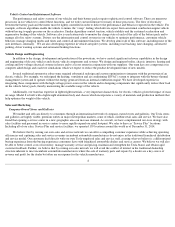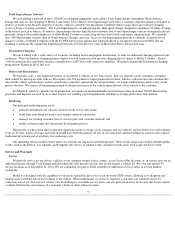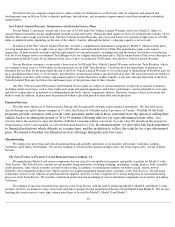Tesla 2015 Annual Report Download - page 19
Download and view the complete annual report
Please find page 19 of the 2015 Tesla annual report below. You can navigate through the pages in the report by either clicking on the pages listed below, or by using the keyword search tool below to find specific information within the annual report.
Problems or delays in bringing the Gigafactory online and operating it in line with our expectations could negatively affect us.
To lower the cost of cell production and produce cells in volume to allow us to grow quickly, we intend to integrate the production of
lithium-ion cells and finished battery packs for our vehicles at our new Gigafactory. Our Gigafactory plan, however, is at an early stage. While
we recently entered into various formal agreements with Panasonic on the Gigafactory, we have very little experience in building a factory of the
size and scope planned for the Gigafactory, and no experience directly in the production of lithium-ion cells. In addition, to date we have not
finalized agreements with additional Gigafactory partners that will be co-located at the Gigafactory. Also, the cost of building and operating the
Gigafactory could exceed our current expectations and the Gigafactory may take longer to bring online than we anticipate. If we are unable to
build the Gigafactory in a timely manner to produce high volumes of quality lithium-ion cells at reasonable prices, then our ability to supply
battery packs to our vehicles, including Model 3, according to our schedule and/or at a price that allows us to sell them profitably and in the
quantities we estimate could be constrained. Any such problems or delays with Gigafactory could negatively affect our brand and harm our
business, prospects, financial condition and operating results.
If our vehicles or vehicles that contain our powertrains fail to perform as expected, or if we suffer product recalls, our ability to develop,
market and sell our electric vehicles could be harmed.
Our vehicles or vehicles that contain our powertrains such as the Toyota RAV4 EV or the Mercedes-Benz B-Class EV may contain
defects in design and manufacture that may cause them not to perform as expected or that may require repair. For example, our vehicles are
highly dependent on software to operate. Software products are inherently complex and often contain defects and errors when first introduced,
and changes to software may have unexpected effects. Model S issues experienced by customers include those related to the software for the 17
inch display screen, the panoramic roof and the 12 volt battery. Although we attempt to remedy the Model S issues experienced by our
customers in a rapid manner, such efforts may not be timely or up to the satisfaction of our customers.
While we have performed extensive internal testing, we currently have a limited frame of reference by which to evaluate the long-term
performance of our battery packs, powertrains and vehicles. Specifically, we have only a limited amount of data by which to evaluate Model S,
upon which our business prospects depend, due to the fact that we only recently began production in June 2012. There can be no assurance that
we will be able to detect and fix any defects in the vehicles prior to their sale to consumers.
We have experienced product recalls, including in May 2009, October 2010, and June 2013, all of which were unrelated to our electric
powertrain. In May 2009, we initiated a product recall after we determined that a condition caused by insufficient torqueing of the rear inner hub
flange bolt existed in some of our Tesla Roadsters, as a result of a missed process during the manufacture of the Tesla Roadster glider, which is
the partially assembled Tesla Roadster that does not contain our electric powertrain. In October 2010, we initiated a product recall for some of
our Tesla Roadsters after the 12 volt, low voltage auxiliary cable in a single vehicle chafed against the edge of a carbon fiber panel in the vehicle
causing a short, smoke and possible fire behind the right front headlamp of the vehicle. In June 2013, we initiated a recall of slightly more than a
thousand Model S vehicles to inspect and repair rear seat strikers that may have been compromised during the assembly process. Rear seat
strikers are used to retain the rear seat backs in an upright position. Failure of this component may have resulted in the collapse of the rear seat
back during a crash. Although the cost of this recall was not material, and limited to a small number of total Model S’s produced, we may
experience additional recalls in the future, which could adversely affect our brand in our target markets, as well as our business, prospects and
results of operations.
In January 2014 we implemented a firmware update to address issues with certain Universal Mobile Connector NEMA 14-50 adapters,
which are part of the charging units and are not part of the vehicles themselves, potentially overheating during charging. We further announced
that we would provide upgraded NEMA 14-50 adapters to our customers as an additional safeguard. If such measures do not adequately address
the underlying concerns, our business, prospects and results of operations could be harmed.
Our electric vehicles may not perform consistent with customers’ expectations or consistent with other vehicles currently available. For
example, our electric vehicles may not have the durability or longevity of current vehicles, and may not be as easy to repair as other vehicles
currently on the market. Additionally, while Model S recently achieved an overall five star safety rating by NHTSA, there is no guarantee that
future model years or variants or other Tesla vehicles will also attain such safety ratings, and any such rating is not a guarantee of safe product
design or that any individual vehicle will be free of any defect or failure.
Any product defects or any other failure of our performance electric vehicles to perform as expected could harm our reputation and result
in adverse publicity, lost revenue, delivery delays, product recalls, product liability claims, harm to our brand and reputation, and significant
warranty and other expenses, and could have a material adverse impact on our business, financial condition, operating results and prospects.
18
























